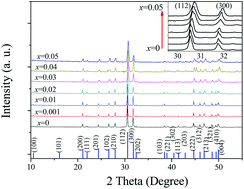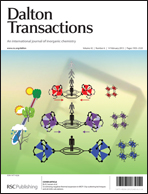Blue-emitting phosphors of the Ce3+-activated phosphosilicate Sr5(PO4)2SiO4 with an apatite structure were prepared via a conventional solid-state reaction method. The X-ray diffraction (XRD), scanning electron microscopy (SEM), photoluminescence (PL) spectra, time-resolved luminescence, thermal quenching and luminescence decay curves (lifetimes) were applied to characterize the phosphors. The effects of the Ce3+ activator concentration on the phase evolution and luminescence properties were investigated. Sr5−5xCe5x(PO4)2SiO4 (x = 0.03) exhibits the brightest blue emission with CIE coordinates of (x = 0.185, y = 0.165) and a quantum efficiency of 46%. The crystallographic site of the Ce3+ ions in the Sr5(PO4)2SiO4 lattice was identified and discussed. There is only one distinguishable crystallographic Ce3+ site occupied on a Sr(II) site in the Sr5(PO4)2SiO4 lattices, which results in a typical doublet emission band. The wavelengths of the excitation and emission bands show a red shift with increasing Ce3+ doping concentration. The luminescence features of the Ce3+ ions were discussed on the base of the crystal structure. The thermal stability of the blue-emitting phosphors was evaluated by the temperature-dependent luminescence and the activation energy of the thermal quenching.

You have access to this article
 Please wait while we load your content...
Something went wrong. Try again?
Please wait while we load your content...
Something went wrong. Try again?


 Please wait while we load your content...
Please wait while we load your content...